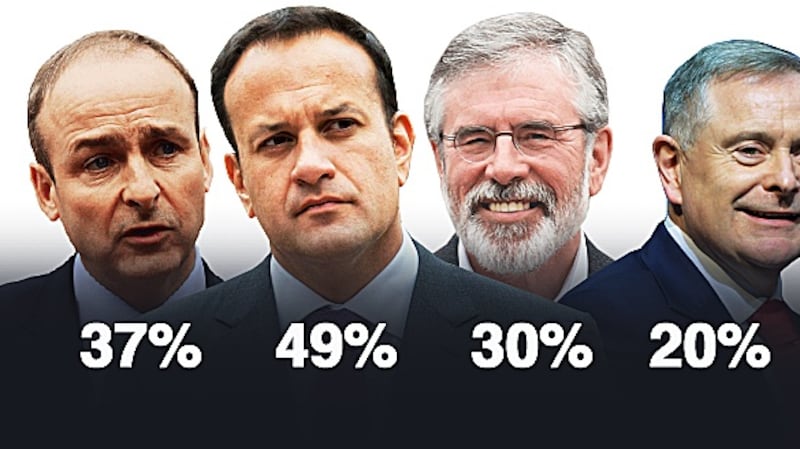With less than a week to budget day, today's Irish Times/Ipsos MRBI poll shows Fine Gael (on 31 per cent, up one point) maintaining a marginal lead over Fianna Fáil (on 29 per cent, up two points).
The poll also reveals a widening gap between the two leading parties and the rest. Sinn Féin has dropped back marginally (down one point, to 19 per cent), as have Independents/Others (down one point, to 17 per cent) and Labour (down one point, to 4 per cent).
Overall satisfaction with the Government is at 36 per cent, one point lower than in our May poll.

This latest survey was conducted on Monday and Tuesday of this week among a nationally representative sample of 1,200 adults across 100 sampling points and covering every constituency in the country.
Much is already known about the contents of Budget 2018. There are unlikely to be any surprises or significant policy announcements next Tuesday. From what has been hinted at so far it looks as if additional Government spending will be spread so thinly that its influence on voter preferences will be limited. Today's poll findings do not signal a substantial budget vote boost for the Government.
Financial prudence
Prudence is required from the Minister for Finance, despite a growth rate the envy of Europe. We are still borrowing to fund day-to-day spending, and a large chunk of what Paschal Donohoe has managed to find down the back of his sofa has been gobbled up by public-sector pay rises. A one-point increase for Fine Gael suggests voters have priced in very modest gains from this year’s budget.
The point at which Ireland’s current account will be in surplus is getting ever nearer, and Fine Gael will be hoping to stay in government long enough to be able to turn the tap back on. It would be a cruel irony if Fianna Fáil were to get back into government just in time to ride the crest of a new economic wave.

The standout political event of the past year has been the change of Fine Gael leader, and since our last poll, in May, voters have had plenty of time to size up our new Taoiseach.
Taking the reins just as the Dáil went into recess did not give the new Leo Varadkar an opportunity to hit the ground running. The Dáil is now back in session, and heated exchanges with Mary Lou McDonald are just what he needs to remind voters that he is more than a social-media phenomenon.
Satisfaction with Varadkar's performance as Taoiseach is high, at 49 per cent, with 31 per cent dissatisfied and 20 per cent undecided. Enda Kenny began his tenure in 2002 with a 28 per cent satisfaction rating as leader of Fine Gael, so Varadkar has got off to a flying start by comparison.
He is also, by a distance, the most highly rated leader, noticeably ahead of Micheál Martin (down two points, to 37 per cent), Gerry Adams (down one point, to 30 per cent) and Brendan Howlin (down two points, to 20 per cent).
Broader appeal
For Fine Gael the expectation, or at least the hope, was that Varadkar would broaden the party’s appeal. Traditionally Fine Gael has struggled to capture the attention of younger voters, who are cynical of politics and doubting of politicians. As a right-leaning establishment party, Fine Gael neatly fits the stereotype of a party not to be trusted.
In so many ways our new Taoiseach is not an establishment politician, which ideally positions him to capture the imagination of young voters. And it is not an impossible task: the marriage-equality referendum proved this generation can be inspired and get engaged.
Today’s poll provides an early indication of the degree to which Fine Gael’s new leader is connecting with younger voters. Among 18- to 34-year-olds, satisfaction with Fine Gael’s leader is 47 per cent, a full nine points higher than Enda Kenny achieved in his final poll. Encouragingly, he rates as highly as Kenny among older voters, so no signs yet that his youth appeal is alienating older voters.
Curiously, Varadkar’s personal popularity is not translating into votes among young voters. Party support is at 22 per cent among under-35s, down from the 25 per cent in our May poll. Clearly, a likable leader is not a sufficient reason to change party allegiance for some voters.
If young people are a chink in Fine Gael’s armour, working-class voters are a gaping hole. It is therefore noteworthy that the most obvious shift in Fine Gael support among different socioeconomic groups is a jump from 22 per cent to 29 per cent support within the skilled-working-class category. Perhaps the “party for those who get up early” message is resonating, or the promise of tax cuts is cutting through among low- to middle-income earners.
Closely contested
Fianna Fáil remains in Fine Gael’s slipstream and has closed the gap to just two points. We can expect the next election to be very closely contested. Of course this also means, as things stand, that we are set for another confidence-and-supply agreement unless one party decides to go into government with Sinn Féin.
Sinn Féin has given up one point for a second successive poll, although shifts of this magnitude are marginal, and the party remains ahead of its performance in the 2016 general election.
For Independents/Others the trend has been steadily downwards since they recorded 30 per cent in last year’s election. Now on 17 per cent (down one point), this grouping is back to its 2012 level of support.
Labour, on just 4 per cent, has yet to recover any momentum. It now performs worse, on average, among working-class than middle-class voters, which was not the case a decade or two ago. Sinn Féin has undoubtedly taken a larger share of the working-class pie in recent years, and with voters drifting towards the establishment parties as the economy strengthens, Labour risks being caught in the middle.
None of the movements in party support between this poll and our poll in May could be considered statistically significant. That said, the centre of gravity appears to be moving slowly from left to right as confidence in the economy returns. The most relevant battle from a government-formation perspective will be the tug of war between Fine Gael and Fianna Fáil, which remain in a statistical dead heat, for the time being at least.











